|
Medici in Florence
5 generationen 1389-1574
| ||||||||||||||||||||
Medici family tree for the five generations 1389-1574
|
Here the continuation page for part 2
Alessandro, 1510-37, 1st Duke since 1532 Lorenzino, 1514-48 Cosimo I., 1519-74, 2nd Duke in 1537, Grandduke of Toskana in 1569 |
| Although members of the Medici family largely determined the fate of the Republic of Florence in the fifteenth century, they were not involved officially in the government. Their portraits did not appear on coins, but on medals. This changed only after the unrest caused by Savonarola and the Sacco di Roma (1527). |
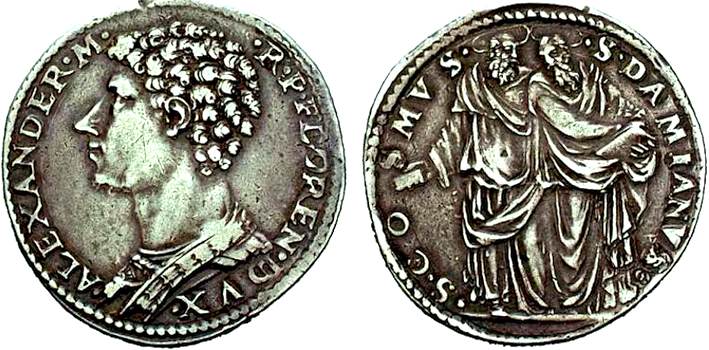
Testone n. d. Dies by Benvenuto Cellini. Ø 30 mm, 9,87 g. CNI XII 244/16; RM 323/1. Obv.: ALEXANDER·Medici· - ·Rei·Publicae·FLORENtinae·DVX· Rev.: ·Sanctus·CO - SMVS· - ·Sanctus·DAMIANVS· "Saint Cosmas - Saint Damian" Cosmas (with drug bottle) and Damian (with book in hands) are the Christian patrons of physicians. This is the earliest coin bearing the image of a Medici.
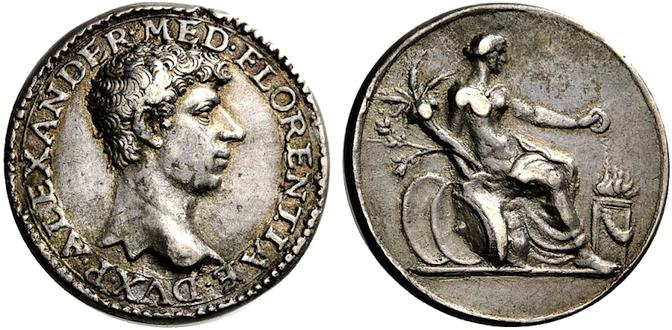
Silver medal 1534. Dies by Domenico di Polo de' Vetri. Ø 33 mm, 22,86 g, 6h. Cast from minted original. Obv. see Attwood 774-775. Rev. unknown, compare Attwood 770-771. Obv.: ·ALEXANDER·MED·FLORENTIAE·DVX·P - head to the right. Rev.: A female figure, half draped, sitting directly on a pile of shields, holds a cornucopia with her right hand, and pours with her left hand a libation from a patera over a burning altar to the right. The inscriptions are raised like in general with minted coins.
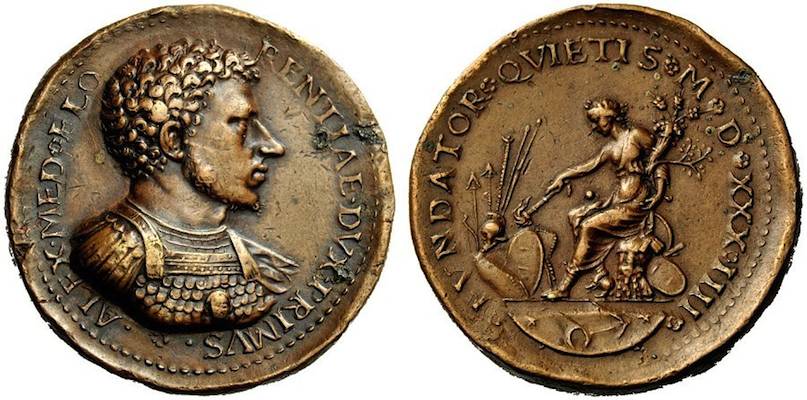
Struck bronze medal 1534, by Domenico de Vetri. Ø 40 mm, 46,24 g. Pollard 322/A. Obv.: ·ALEX·MED·FLO - RENTIAE·DVX·PRIMVS· - cuirassed bust to the right. Rev.: FVNDATOR·QVIETIS·M·D·XXX·IIII· "quit established" - The personification of Peace holds a cornucopia and an olive branch while setting a pile of weapons on fire.
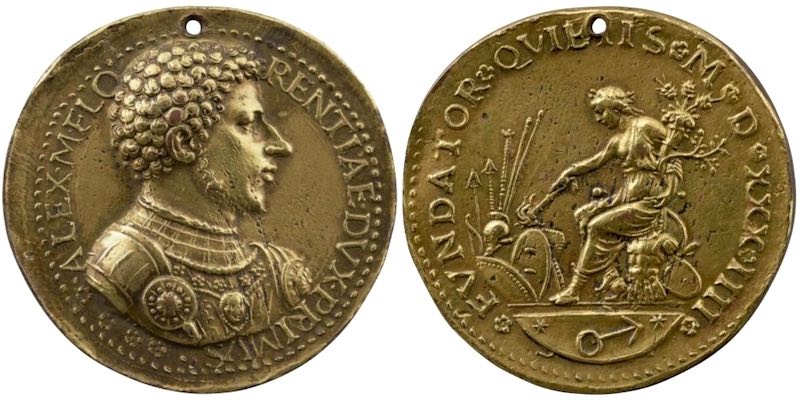
Struck bronze medal 1534, by Domenico di Polo de Vetri. Ø 38 mm. Specimen in The Frick Collection, gift of Stephen K. Scher and Janie Woo Scher, N.Y.  . .
·ALEX·M·FLO - RENTIAE·DVX·PRIMVS·¤¤¤¤ // ¤FVNDATOR¤QVIETIS¤M¤D¤XXX¤IIII¤ Similar as before.
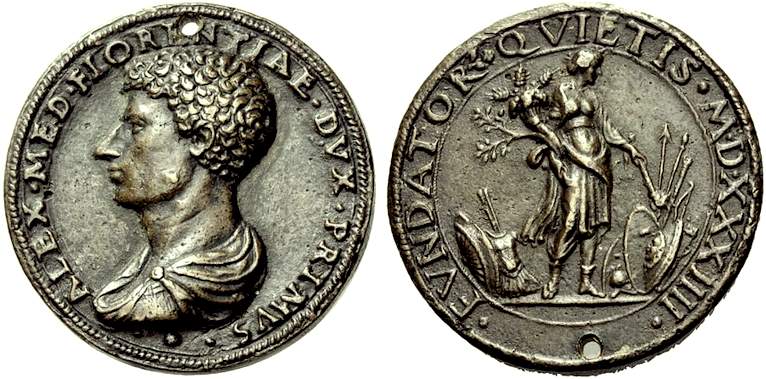
Bronze medal 1534, dies by Domenico de Vetri. Ø 44 mm, 45,6 g. Armand I 151/1; Museo Nazionale del Bargello - Medaglie Italiane del Rinascimento II, p.649 no.321. Obv.: ALEX·MED·FLORENTIAE·DVX·PRIMVS·•· - draped bust left. Rev.: ·FVNDATOR ᕠ QVIETIS·M·D·XXXIIII· - the personification of Peace holds a cornucopia and a olive branch while she puts a pile of arms on fire. The hole served to wear the medal by the collar. The misaligned sides (↑↓) did not prevent this purpouse.
|
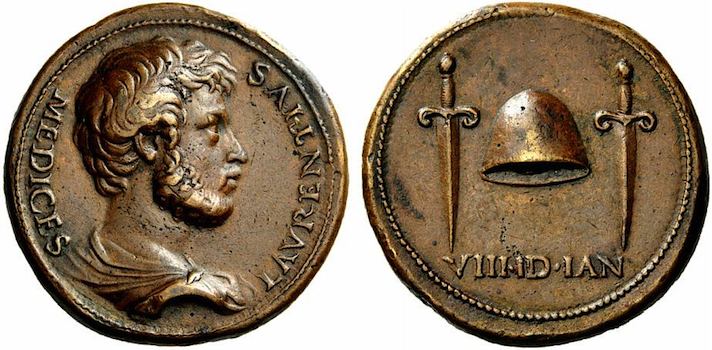
Bronze medal n. d. (1537-48) Ø 36 mm, 26,40 g. Toderi Vannel Medaglie 743; Attwood 891; Calveri 19; Börner 897. Obv.: LAVRENTIVS MEDICES - effigy right. Rev.: Liberty cap between two daggers, including: VIII·ID·IAN "8th day before Ides (the 13th day of the month) in January" (= 6th January of the Roman calendar).
|
1st period 1537-57 : Cosimo I de' Medici as Duke of the Republic of Florence
COSMUS MEDICEUS REIPUBLICAE FLORENTINAE DUX
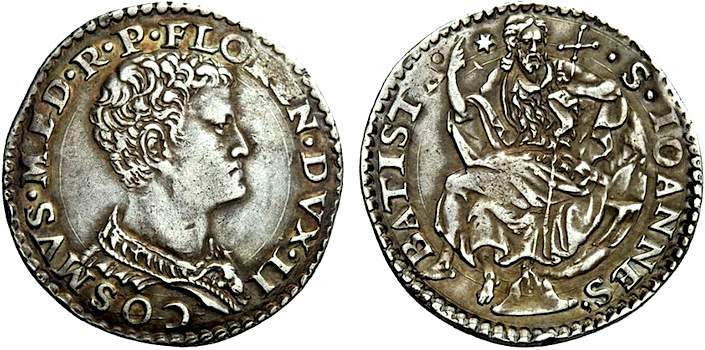
Testone da 40 soldi. Ø 30 mm, 9,44 g. CNI XII 252/49; RM 327/5; MIR 119 (this piece). Obv.: COSMVS·MEDiceus·Rei·Publicae·FLORENtinae·DVX·II "..., 2nd duke of the Republic of Florence" beardless youthful portrait right. Rev.: · S·IOANNES· - BATISTA· - * seated John the Baptist from the front, blessing with his right hand, in his left hand a cross bar.
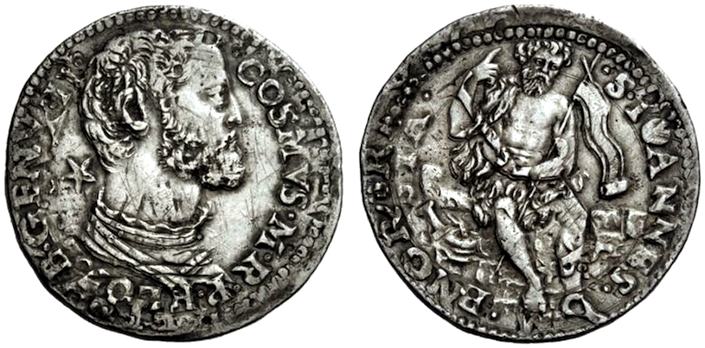
Testone da 43 soldi. Ø 30 mm, 9,79 g. CNI 250/33var; RM 326/4 (this piece); MIR 125. Obv.: COSMVS·Mediceus·Rei·Publicae·FLORENtinae·DVX·II - bearded effigy right, behind him a star. Rev.: · S·IOANNES· - ·BATISTA· - John the Baptist seated on a wall, wearing fur, cross bar with banners; bowl with spoon on the left. Overstrike. This is an overstrike of a Blessing Teston from Genoa (...VB*GENV... / ...NOR*R... still visible),
from which many circulated in Florence. Such pieces should be higher in value than the usual Testoni from Florence. They got the name Stellino after the star behind the bust.
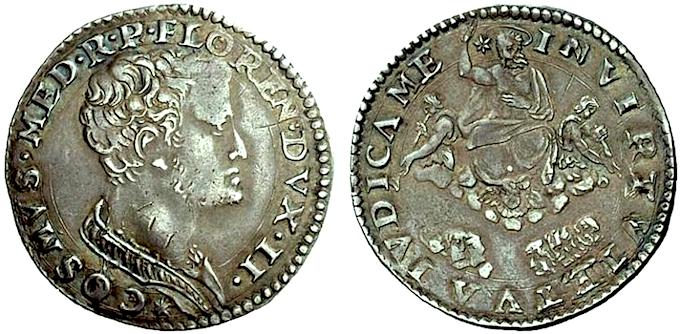
Lira n. d. Ø 27 mm, 4,76 g. CNI 255/73; RM 329/10. Obv.: *COSMVS·MED·R·P·FLOREN·DVX·II· - youthful bust to the right. Rev.: IN VIRTVTE TVA IVDICA ME - * "Judge me in your goodness" - The Last Judgement: The Holy Father seated between two trumpeting angels on a cloud with angel head inside. Below two times three heads.
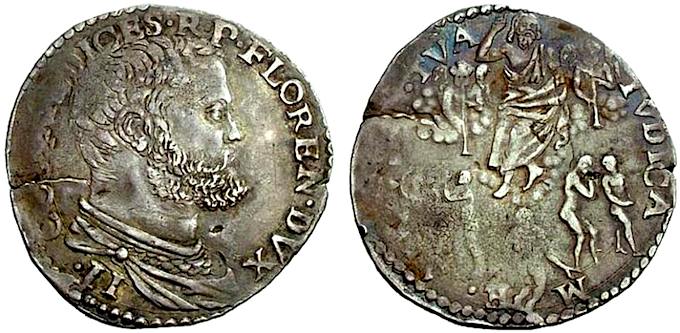
Lira n. d. Ø 27 mm, 4,56 g. CNI 256/81; RM 330/11. Obv.: *COS·MEDICES·R·P·FLOREN·DVX - II· - bearded bust right. Rev.: IN VIRTVTE ·TVA - IVDICA M - E· "Judge me in your goodness" - The Last Judgement: The Holy Father standing between two trumpeting angels on a cloud. Below five persons.
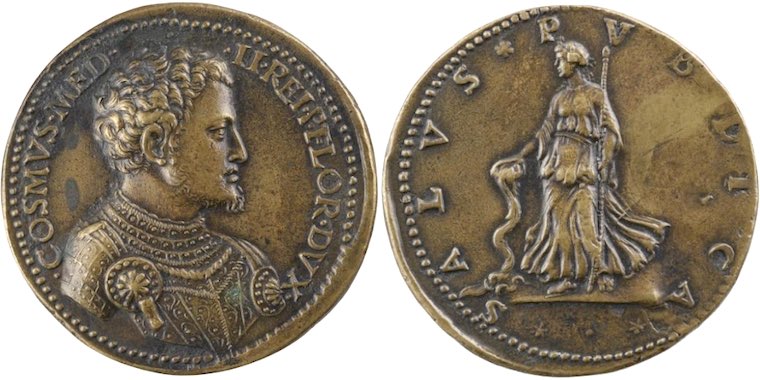
Struck bronze medal (1537-69) by Domenico di Polo de Vetri. Ø 36 mm. Specimen in the Frick Collection, gift of Stephen K. and Janie Woo Scher, 2021  . .
·COSMVS·MED· - ·II·REI P·FLOR·DVX // ⁎SALVS⁎PVBLICA⁎
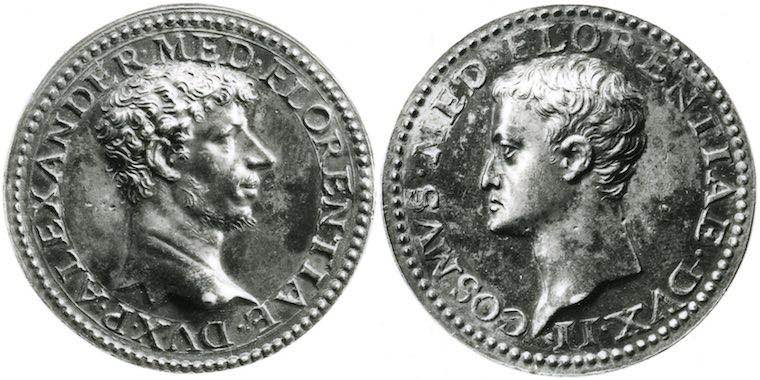
Struck silver medal, n.d. (1537) by Domenico di Polo de Vetri. Ø 36 mm, 22,93 g. Attwood 776a; Kress 316 (aftercast). Struck specimen from The British Museum, London  . .
Obv.: ALEXANDER·MEDices·FLORENTIAE·DVX·Primus· - Head of Alexandro, 1st duke. Rev.: COSIMVS·MEDices·FLORENTIAE·DVX·II - Head of Cosimo, 2nd duke.
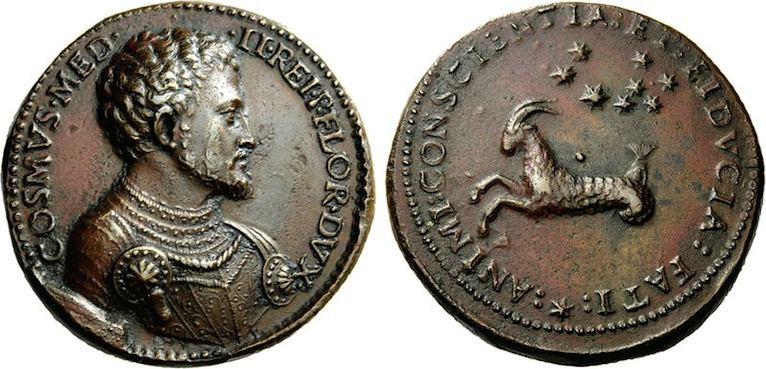
Struck bronze medal, n. d. (after 1537) by Domenico di Polo de Vetri. Ø 34 mm, 26,6 g. Attwood 783; Kress 315. Obv.: COSMVS·MEDices· - ·II·REI·Publicae·FLORentinae·DVX· bareheaded and cuirassed bust to the right. Rev.: :ANIMI:CONSCIENTIA:ET:FIDVCIA:FATI: "with a clear conscience and (in) confidence in fate" Capricorn to the left; above eight stars of the crown of Ariadne.
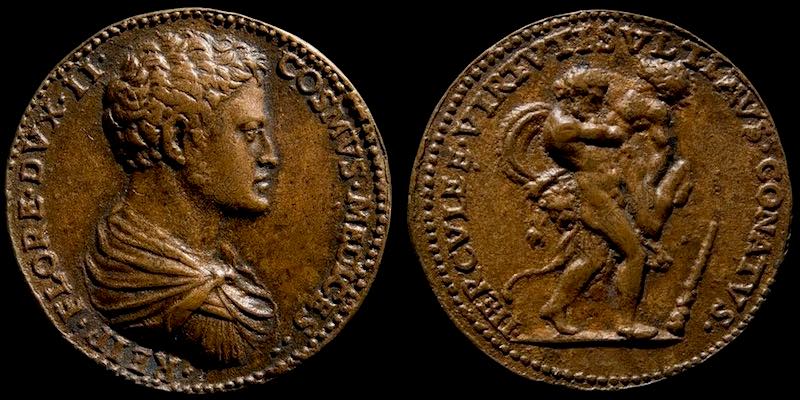
Bronze medal n. d. by Domenico di Polo de' Vetri? Ø 47 mm, compare Attwood 773 in the Brit.Museum. Specimen in Museo Nazionale del Bargello, Florence, Inv. no. 6203 
Obv.: COSMVS·MEDICES· - ·REIPublicae·FLORentinae·DVX·II· - beardless bust to the right. Rev.: HERCVLES·VIRTVTIS VLTIMVS·CONATVS· "the ultimate attempt of Herculean virtue" Heracles and Antaeus. Who is the winner? Hercules, of course, with club and lion skin as his attributes.
The loser is the giant Antaeus because he has lost contact with earth, his mother. Compare the bronze bust 2nd period 1557-69 : Cosimo I de' Medici as Duke of Florence and Siena
COSMUS MEDICEUS FLORENTIAE et SENARUM DUX Cosimo retained this title when he entrusted his son Francesco with the affairs of state in 1563.
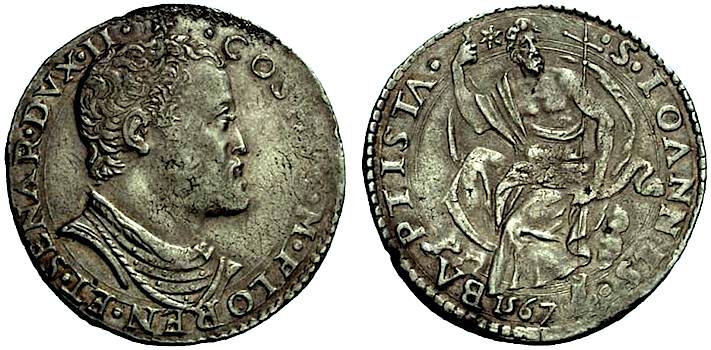
Testone 1567. Ø 30 mm, 9,03 g. CNI XII 267/176; RM 332/14. Obv.: * ·COSMVS·Mediceus·FLOREN·ET·SENAR·DVX·II· - bearded bust right. Rev.: ·S·IOANNES· - BA - PTISTA· - * The seated saint has his right hand raised for blessing, with the left he holds the cross bar.
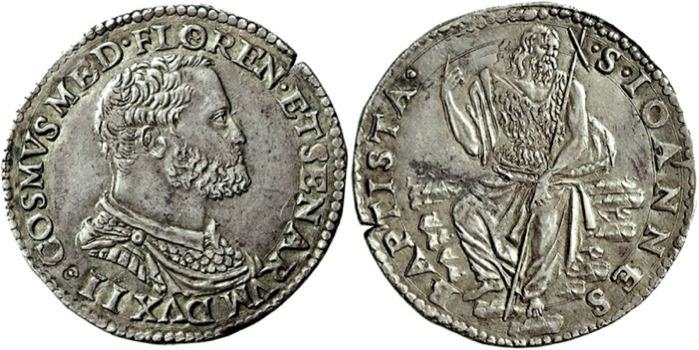
Testone n. d. Ø 30 mm, 9,19 g. CNI XII 271/211; RM 332/14; MIR 149/2. Obv.: *COSMVS·MEDiceus·FLOREN·ET·SENARVM·DVX·II - bearded bust right. Rev.: ·S·IOANNES· - BAPTISTA· The seated saint has his right hand raised for blessing, with the left he holds the cross bar.
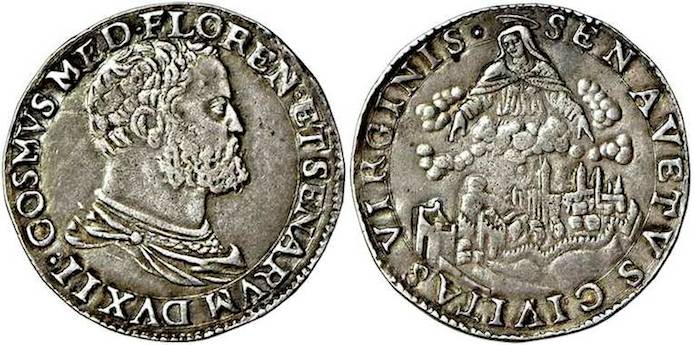
Testone n. d. (1557-69). Ø 30 mm, 9,21 g. CNI XI 416/10; RM 337/21; MIR 578. Obv.: COSMVS MED·FLOREN·ET·SENARVM DVX II· - draped bust right. Rev.: SENA VETVS CIVITAS VIRGINIS· Sena vetus civitas Virginis = "ancient Siena, city of the Virgin" View of the city of Siena, above half figure of the Virgin Mary in clouds.
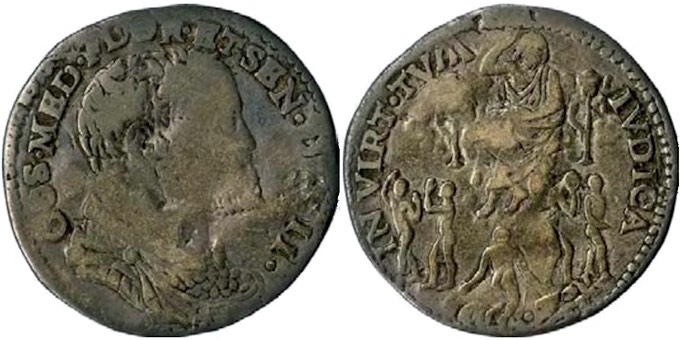
Lira o. J. (1558-61). Ø 28 mm, 4,2 g. CNI XII 273/223; RM 333/15. Spacimem from Collezione di Vittorio Emanuele III, BdN Materiali 15 (2014) p.51. Obv.: COS·MEDiceus·FLORentiae·ET SENarium·DVX II· - draped bust right. Rev.: IN VIRTute·TVA - IVDICA - M - E "Judge me in your goodness" - The Last Judgement.
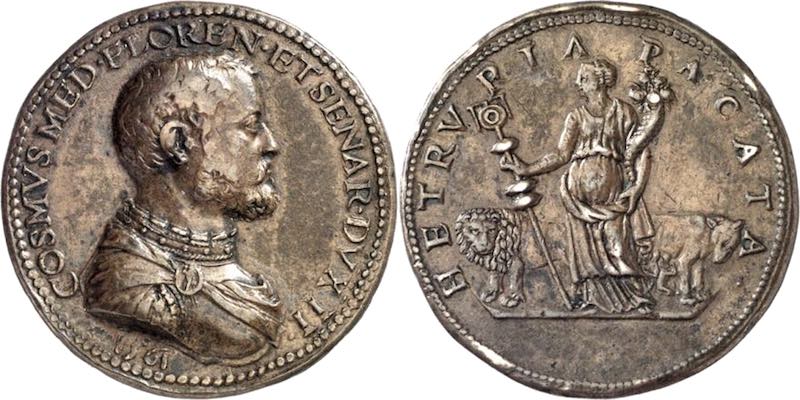
Struck bronze medal 1561 by Domenico Poggini. Ø 42 mm. Armand I 256/12; Attwood 813; Pollard (2007) 390a; Toderi/Vannel 1569. On the capture of Siena in 1555 and the confirmation of the annexation at the Tuscan Peace through the Treaty of Cateau-Cambrésis in 1559. Obv.: COSMVS MEDices·FLORENtiae·ET SENARum·DVX II· "Cosimo de' Medici, 2nd duke of Florence and Siena" Draped and cuirassed bust to the right, below the date 1561. Rev.: HETRVRIA PACATA "Tuscany pacified" - Concordia standing facing, head to the left, a standard in her right hand and a cornucopia in her left; behind her on the left the lion of Florence and on the right the she-wolf with the twins of Siena.
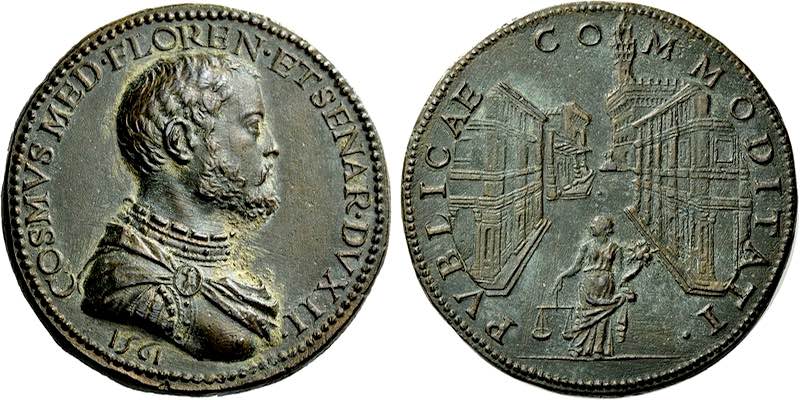
Struck bronze medal 1561 by Domenico Poggini. Ø 40 mm, 35,08 g. Armand I 256/13; Attwood 812a; Kress 341; Pollard (2007) 387. Obv.: COSMVS MEDices·FLORENtiae·ET SENARum·DVX II· "Cosimo de' Medici, 2nd duke of Florence and Siena" Draped and cuirassed bust to the right, below the date 1561. Rev.: PVBLICAE COMMODITATI· "For the convenience of the people" View of the Uffizi Gallery, the Loggia della Signoria and the Palazzo Vecchio behind it, in front Aequitas holding scales and cornucopia. The traces of incrustations on the obverse of this coin make it likely that it had been buried as a foundation medal; the traces of cleaning support this view, as do the otherwise pristine surfaces.
The Uffizi was built in 1560-80 for the administration (uffici) and the Medici art collection. The building was designed by Vasari and placed between the Piazza della Signoria and the Arno river.
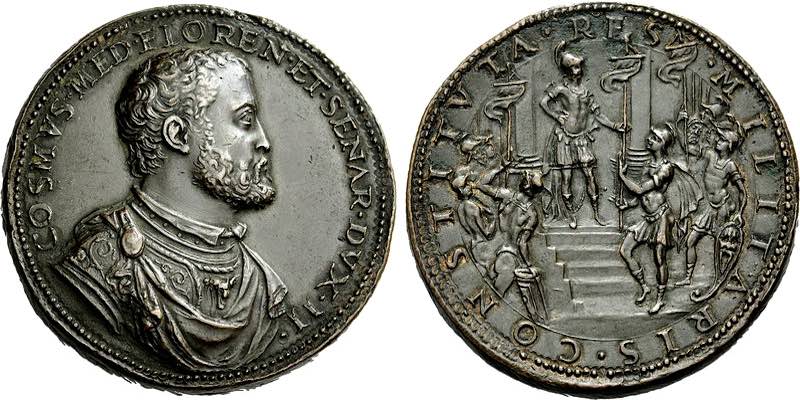
Struck bronze medal n. d. (1567) by Pietro Paolo Galeotti. Ø 43 mm, 45,26 g. Attwood 864. Obv.: COSMVS·MEDiceus·FLORENtiae·ET·SENARum·DVX·II· Bust to the right, bearded, wearing an ornamented cuirass, and a mantle secured at the right shoulder. Rev.: RES - ·MILITARIS·CONSTITVTA· "Military affairs settled" - A helmeted soldier, wearing ancient armour, presenting a standard to another, standing between two columns at the top of a short flight of steps. To each side, similar soldiers, holding standards, spears and shields.
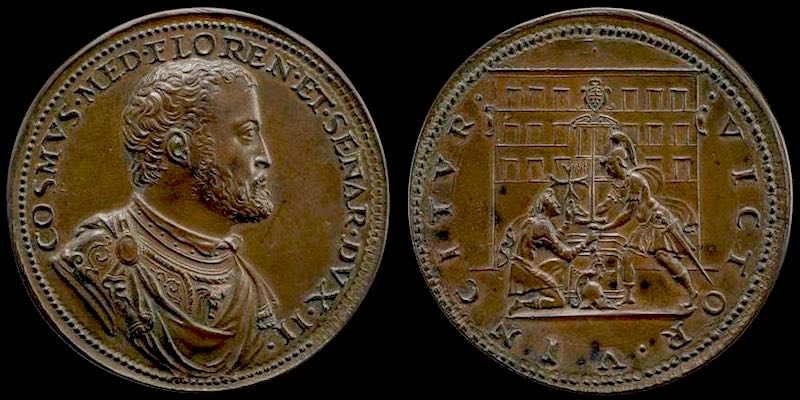
Struck bronze medal n. d. (1567) by Pietro Paolo Galeotti (ca.1520-1574). Ø 43 mm, 42,23 g. Attwood 863a. Specimen in The British Museum 
Obv.: COSMVS·MEDiceus·FLORENtiae·ET·SENARum·DVX·II· Bust to the right, bearded, wearing an ornamented cuirass, as before. Rev.: ·VICTOR·VINCITVR· "The conqueror is conquered (by the charme of Pisa)" A standing figure, helmeted and wearing ancient armour, and a kneeling figure, also wearing ancient armour, holding in his left hand a cross of St Stephen, with his helmet on the ground beside him, both grasping a sword, which they hold vertically before an altar. In the background, the palazzo dei Cavalieri, Pisa. The Palazzo dei Cavalieri was built around 1560 by the architect Giorgio Vasari, who was commissioned by the Medici. The piazza was redesigned and improved. The palace received a curvy facade adorned
with coats of arms and a staircase adorned with statues.
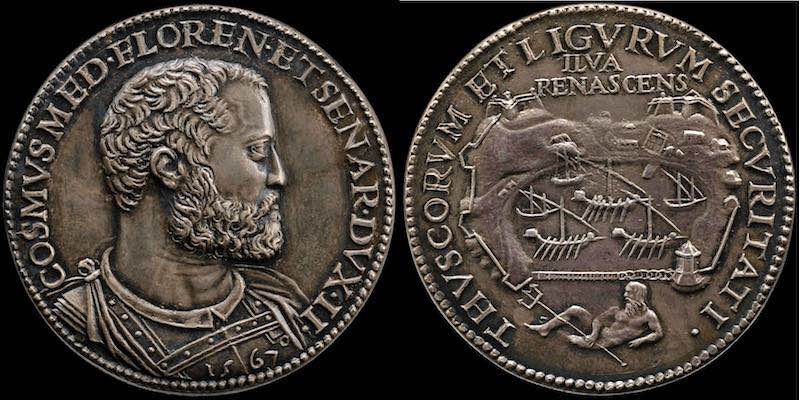
Struck silver medal 1567 by Pietro Paolo Galeotti Ø 40 mm, 35,82 g. Attwood 853a, p.354. Specimen in The British Museum 
Obv.: COSMVS MED·FLOREN·ET SENAR·DVX·II· - Bust to the right. Rev.: THVSCORVM ET LIGVRVM SECVRITATI· - "For the security of the Tuscans and Ligurians" Harbour of Elba, below Neptune with trident, on top: ILVA RENASCENS "Elba reborn" 3rd period since 1570 : Cosimo I de' Medici as Grand Duke of Tuscany
MAGNVS·DVX·ETRVRIAE Pope Pius V raised Cosimo to Grand Duke (granduca) of Tuscany in 1569.
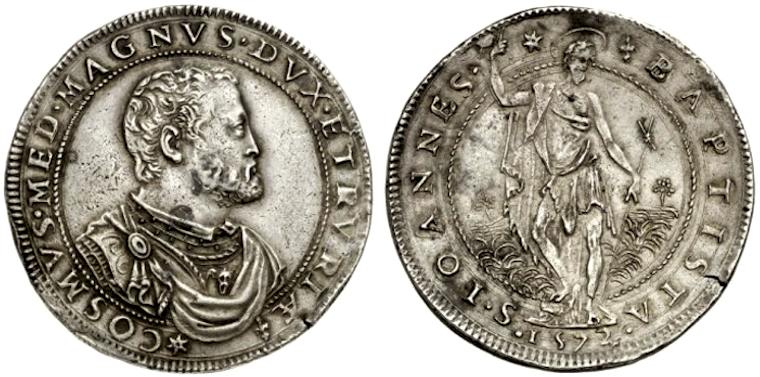
Piastra 1572. Ø 40 mm, 32,46 g. CNI 281/290; RM 334/18; Dav.8383. Obv.: *COSMVS·MED·MAGNVS·DVX·ETRVRIAE ⚜ bust right in armor with slung cloak. Rev.: S·IOSNNES· - * - ⚜ - BAPTISTA· slim St. John stands from the front with crosier and right hand raised. Below the date ·1572·. The dies of this coin is from Pietro Paolo Galeotti, the successor of Benvenuto Cellini.
The Piastra of the years 1568-9 still carry the old title: COSMVS MEDICES FLORENtiae et SENARum DUX II.
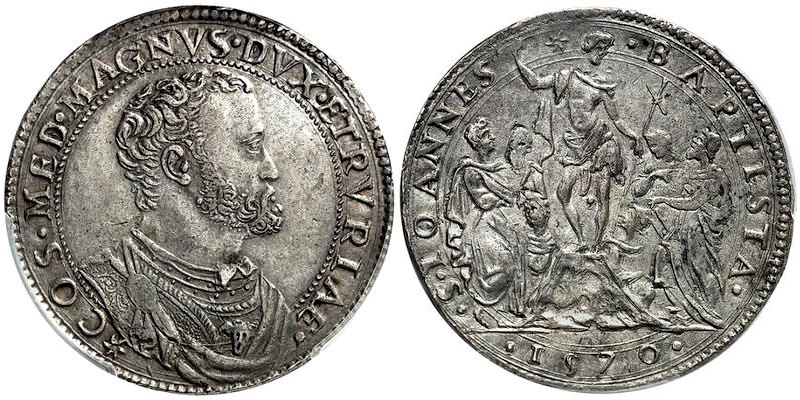
Mezza Piastra 1570. Ø 36 mm, 16,07 g. CNI 278/265; RM 335/19. *COS·MED·MAGNVS·DVX·ETRVRIÆ· // ·S·IOANNES· - * - BAPTISTA· The half Piastra from 1569 still carry the older title: COSMVS MED FLOREN ET SENAR DUX II.
The coins of Cosimo I. shown here are usually made of 958/1000 fine silver. |
|
Ref.: • Corpus Nummorum Italicorum [CNI]: Florenz in Bd.XII sowie vermeintlich Siena in Bd.XI - CNI-Index 
• Bollettino di Numismatica online  : Materiali 14, 15 e 19 : Materiali 14, 15 e 19
• Ravegnani Morosini, Mario [RM]: Signorie e principati - monete italiane con ritratto, 1450-1796, 1984 Medici: Bd.II, S.323-337 • Alessio Montagano [MIR]: Monete italiane Regionali: Firenze, Pavia, Numismatica Varesi, 2011 • A. Galeotti: Le monete del Granducato di Toscana, Livorno, 1929 • G.Toderi / F.Vannel: Le Medaglie Italiane del XVI Secolo, vol.1-3, 2000 • G.Toderi / F.Vannel: Medaglie Italiane del Museo Nazionale del Bargello, vol.I: sec. XV-XVII, 2003 • Vannel / Toderi [V&T]: La Medaglia Barocca in Toscana, Firenze 1987 • Kress: Renaissance Medals from the Samuel H. Kress Coll. at the National Gallery of Art, 1967 • J. Graham Pollard: Renaissance medals, the Collection of the Nat. Gallery of Art, vol.1 (Italy), 2007 • Attwood, Philip: Italian Medals c.1530-1600 in British Public Collections, 2003 |
 start page
start page
